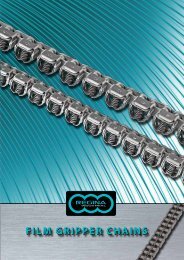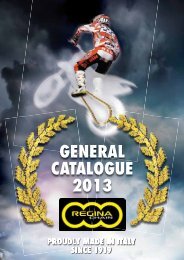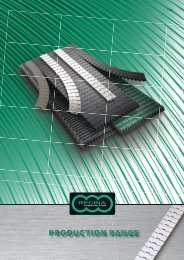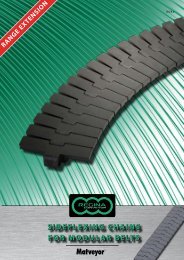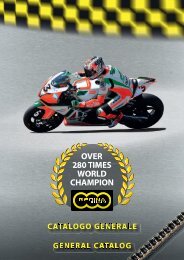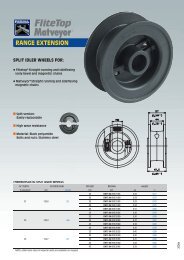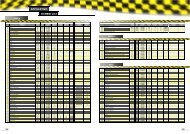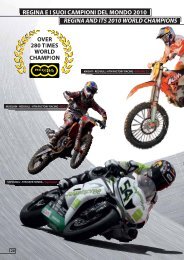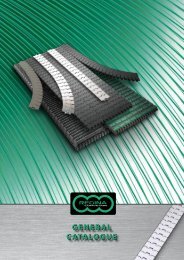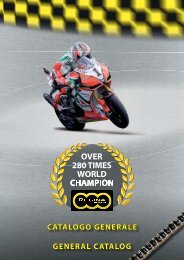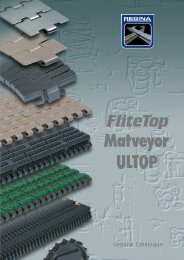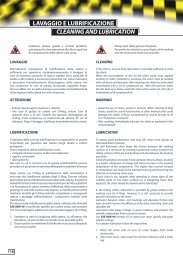Catalogo Generale Industrial - Regina
Catalogo Generale Industrial - Regina
Catalogo Generale Industrial - Regina
Create successful ePaper yourself
Turn your PDF publications into a flip-book with our unique Google optimized e-Paper software.
CATALOG ORGANIZATION AND GUIDE TO CONSULTATIONORGANIZZAZIONE E GUIDA ALLA CONSULTAZIONE DEL CATALOGO10The catalog, in all its below-described sections, provides references tothe most common APPLICATIONS for which our products areemployed. A description of the codes for every application is givenboth on the front inside cover and on the flap of the back cover, thusallowing easy consultation as the reader browses through the catalog.This “chart” also provides a key to materials and shows AVAILABILITYof products (chains and attachments) for Light Conveying.The first part of the POWER TRANSMISSION section (pages 12 to 21)describes the parts that make up a roller chain and the maincharacteristics of the various power transmission chain ranges.Information is given on the standard chains (with case-hardened pins, tocite the most obvious characteristic) of the European and Americanseries, Chroma chains with chromized pins and coated, shapedbushings, corrosion-resistant products (Chroma Extra, chemically nickelplatedand stainless steel chains) and permanently lubricated chainswith O-ring seals. Also described are double-pitch chains, those ofspecial dimensions and, finally, the Chabelco range for heavy-dutytransmission and the Oil Field series (the latter are dealt with in moredetail in the specific catalog). The second part (pages 22-32) providesthe technical and size tables for the above-mentioned ranges. The finalpart (pages 33-38) describes loose parts (connecting links, offset linksetc.), patented <strong>Regina</strong> CRT chain tensioners and chain breakers.The LIGHT CONVEYOR section consists of a first part (pages 40-41)that describes the special constructive features of these chains (specialtolerances on length, matching, special lubrication solutions etc.) andexplains how to code the required attachment chain at the time of order.The next part (pages 42-97) describes every product range and alsoincludes the technical and dimensional data tables. In this second partyou will also find a description of the renewed and extensive range ofspecial attachments sorted according to their general shape (pages 47-87). The shapes of these attachments are also shown in the index onpage 158, grouped together according to base chain. There aresignificantly improved new features on the PIN OVEN (can conveyors)(pages 88-89) and FLY ROLLER (build-up) (pages 90-93) chains.The TENSION LINKAGE section describes the constructive propertiesand characteristics (pages 100-103) of these chains while technicaland dimensional data tables (series AL, BL, UF and LL) are given onpages 104 to 106. Note that the BL range has been extended.The AGRICULTURAL section has been completely revised with respectto the contents of past catalogs. Pages 109 and 110 show the technicaland geometrical characteristics of all the base chains (withoutattachments), both for the ANCO and CA series. Following this comeall the available attachments for combine harvester conveyors (pages111-113), all the attachments for combine harvester elevators (page114) and, finally, corn-picker attachments (pages 115-116). Pages 117and 118 show the renewed chain range (mostly with hollow pins) forsugar cane harvesting machines. Page 118 closes with data on chainsfor roundbalers. Finally, on pages 119 and 120 there are <strong>Regina</strong>producedsteel detachable chains and attachments still used inrelatively less demanding applications.The ENGINEERING section explains (on pages 122 to 123) the maincriteria employed in designing a transmission chain. Then follows adescription of the power transmission chain selection procedure (pages124-137). The procedure for the selection of light conveyor chains forhorizontal (also during accumulation), inclined and vertical conveyorsis given on pages 138 to 145. Notes on how to select tension linkagechains are provided on page 146. Installation and maintenance ofroller chains in general is described on pages 147 to 151 while thesame topic concerning tension linkage chains is dealt with on pages152 and 153.Unit conversion tables and resistance to chemical agents tables andvarious product indexes are given from page 154 onwards.Il catalogo riporta in tutte le sue sezioni, descritte qui di seguito, riferimentisulle APPLICAZIONI più comuni a cui vengono destinati i prodottiproposti. La descrizione dei codici per ogni applicazione è riportata sianella copertina interna che sulla “patella” del retrocopertina estraibile equindi costantemente consultabile mentre si sfogliano le pagine del catalogo.Questa “patella” riporta pure la legenda sui materiali e sulle DI-SPONIBILITA dei prodotti (catene ed attacchi) per il Trasporto Leggero.La sezione TRASMISSIONE DI POTENZA riporta nella prima parte (pagine12 a 21) descrizioni sulle parti che compongono una catena a rullie sulle caratteristiche principali delle varie gamme di catene per la trasmissionedi potenza. Si parla qui delle catene standard (a perni cementati,per citare la caratteristica più evidente) serie Europea ed Americana,delle catene Chroma a perni cromizzati e bussole sagomate rivestite, deiprodotti resistenti alla corrosione (Chroma Extra, catene nichelate chimicamentee in acciaio inox), delle catene a lubrificazione permanente sigillatacon O-Ring. Si descrivono pure le catene a passo lungo, a dimensionispeciali ed infine la gamma Chabelco per trasmissioni pesanti e lecatene della serie Petrolio (queste ultime sono trattate più in dettaglio nellospecifico catalogo). La seconda parte (pagine 22-32) riporta le tabelletecniche e dimensionali delle gamme citate prima . Infine l’ultimaparte (pagine 33-38) descrive le parti staccate (giunti, maglie false ecc.),i tendicatene <strong>Regina</strong> CRT brevettati, e gli smontacatene.La sezione TRASPORTO LEGGERO è composta da una prima parte (pagine40-41) che descrive le speciali caratteristiche costruttive di queste catene(tolleranze speciali sulle lunghezze, appaiamento, lubrificazioni specialiecc. ) e che spiega come comporre i codici descrittivi al momentodell’ordine. La seguente parte (pagine 42-97) descrive ogni gamma diprodotto e contemporaneamente riporta le tabelle tecniche e dimensionali.All’interno di questa parte si descrive la gamma aggiornata e particolarmentericca di attacchi speciali ordinati per forma della sagoma(pagg. 47-87). Le sagome di questi attacchi sono riportate pure nell’indicea pagina 158 ordinate per catena base. Riteniamo pure significativele novità riportate sulle catene PIN OVEN (trasporto lattine) (pagg. 88-89) e FLY ROLLER (per accumulo) (pagg. 90-93).La sezione TRAZIONE descrive proprietà e caratteristiche costruttive(pagg. 100-103) di queste catene mentre le tabelle tecniche e dimensionali(serie AL, BL, UF ed LL) sono riportate nelle pagine 104 a 106. Lagamma BL è stata ampliata.La sezione AGRICOLTURA è stata completamente rivista se confrontata aprecedenti cataloghi. Le pagine 109 e 110 riportano le caratteristiche tecnichee dimensionali di tutte le catene base (senza attacchi), sia serie AN-CO che CA. A seguire sono proposti tutti gli attacchi disponibili per i trasportatorimietitrebbia (pagg. 111-113), poi tutti gli attacchi per elevatorimietitrebbia (pag. 114) ed infine gli attacchi per punte da mais e trincia(pagg. 115-116). Sulle pagine 117 e 118 è riportata la gamma rinnovatadi catene (in prevalenza a perno forato) per le macchine da raccolta dicanna da zucchero. La pagina 118 si chiude coi dati sulla catena per rotopresse.Infine si propongono a pagina 119 e 120 catene e attacchi deltipo in acciaio stampato (steel detachable) di nostra produzione che ancoratrovano impiego in applicazioni relativamente poco esigenti.La sezione TECNICA spiega da pagina 122 a 123 i criteri principali perla progettazione di una trasmissione a catena. In seguito descrive la proceduradi selezione di catene per la trasmissione di potenza (pagg. 124-137). Si riporta a pagg. 138 a 145 la procedura di selezione delle cateneper il trasporto leggero, per trasportatori orizzontali (anche in fasedi accumulo), inclinati e verticali. Un cenno sulla selezione delle catenetrazione è fatto a pagina 146. L’installazione e manutenzione delle catenea rulli in generale viene trattata a pagg. 147 a 151 mentre lo stesso èfatto per le catene trazione a pagg. 152 e 153.Tabelle di conversione e resistenza agli agenti chimici ed i vari indici perprodotto sono riportati dalla pagina 154 in avanti.



